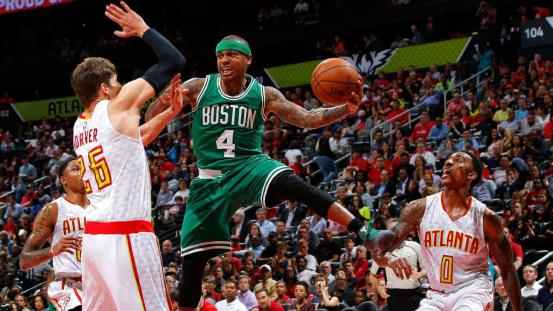- Commissioner’s statement on Ventura, Marte
- Ronnie O’Sullivan: Masters champion ‘felt so vulnerable’ in final
- Arron Fletcher Wins 2017 WSOP International Circuit Marrakech Main Event ($140,224)
- Smith challenges Warner to go big in India
- Moncada No. 1 on MLB Pipeline’s Top 10 2B Prospects list
- Braves land 2 on MLB Pipeline’s Top 10 2B Prospects list
- Kingery makes MLB Pipeline’s Top 10 2B Prospects list
- New Zealand wrap up 2-0 after Bangladesh implosion
- Mathews, Pradeep, Gunathilaka to return to Sri Lanka
- Elliott hopes for rain for Poli
Boston’s season ended when Avery Bradley went down in Game 1
- Updated: April 20, 2016

12:00 AM ET
Avery Bradley is not actually this good. He is uniquely important to Boston’s specific collection of puzzle pieces, and the Celtics’ Game 2 poop-fest in Atlanta laid it bare: For a team built on the synergy and ferocity of its depth, sometimes it only takes one injury for everything to crumble.
The trickle-down effects of Bradley’s injury spread way beyond Brad Stevens playing R.J. Hunter and Terry Rozier in meaningful postseason minutes, as cogs in lineups that had never logged a single second. Stevens started Marcus Smart in Bradley’s place, a smart move, since Smart is the only perimeter player besides Bradley with the wheels to track Jeff Teague; Evan Turner is too slow, Jae Crowder is a shell of himself due to an ill-timed ankle injury, and the Celtics don’t want Isaiah Thomas chasing Atlanta’s shifty point guards.
But Game 1’s random outburst aside, Smart can’t shoot. Boston’s two starting bigs, Jared Sullinger and Amir Johnson, are at their best operating inside the foul line — meaning their defenders can hang there, too. Add Smart’s emboldened defender to the jumble, and poor Thomas had no path to the rim.
Stevens realized it immediately, and barely three minutes into the game, he went small, swapping Evan Turner in for Johnson. Problem: Turner can’t shoot, either. Going small with three non-shooters, including two on the wing, brings none of the benefits of small-ball. It just makes you smaller, which in a vacuum is bad, even in the modern NBA. There’s a reason the key lineups featuring both Smart and Turner also included at least two of Bradley, Jonas Jerebko, and Kelly Olynyk — also missed, due to a shoulder injury.
The Hawks’ defense, No. 2 in the league behind the San Antonio Sharktopuses, is built specifically to strangle teams who can’t shoot. The Hawks leverage the speed of Al Horford and Paul Millsap by having them attack pick-and-rolls out to the 3-point arc, with help defenders behind them flying into the paint to bump opposing big men rolling open toward the rim.
There is a leap of faith, and a deep team-wide trust, in leaving shooters open on the weak side to clog the paint. The Hawks hope their four-armed trap will force opposing ball-handlers to pick up their dribble far from the hoop, and search for any release valve. That outlet won’t be in the paint. It will be a temporarily open player, all the way across the court, and that ball-handler — say a little guy like Thomas — will have to lob a brutal long-distance pass to get the ball there.
The Hawks wager that they can outrun that pass, recover onto those open shooters, and stay in front of them as the shot clock dwindles. Teams who dot the entire floor with good shooters stretch that defense to to its breaking point; the Hawks gave up more 3-point attempts than anyone last season, and it scared them to death.
“We did not like giving up so many 3s,” Mike Budenholzer, the Hawks’ coach, told me in March. “But it’s a constant battle. You can’t pressure the ball like we do without exposing yourselves a bit.”
Teams with poor shooting can’t expose the Hawks that way. Atlanta buries those teams, and without Bradley, the Celtics go from a so-so shooting team to perhaps the worst one in the league outside Philly and Memphis. Whenever one Celtic got some traction toward the rim, he found an extra body walling off his path — as Kent Bazemore does here, veering away from Turner to muck up Smart’s driving lane:
This Smart/Johnson pick-and-roll has no hope with Bazemore sneaking into the restricted area, away from Turner in the right corner, before the play even really gets started:
Smart kicks to Crowder, who might be a better than 50-50 bet to drive past Millsap if he were healthy. He’s not, but just in case, Bazemore stations himself in Crowder’s way rather than recovering onto Turner.
The Hawks made that play more complicated than it needed to be. Kyle Korver, guarding Smart, could have just ducked under Johnson’s screen, daring Smart to pull-up for a brick. Atlanta has done that a ton in this series against Smart, Turner, and even Crowder, who slumped to 33.6 percent from deep after starting hot.
The Celtics are an easy team to shell, doubly so without Bradley. They fit a lot of stuff into every possession — a whir of hand-offs, cuts, and pindowns. Duck under everything, and all the motion amounts to nothing; no Celtic can take the ball within 15 feet of the rim, leaving them desperate. Boston’s mini-rally in the second quarter, which was kind of like a swimmer barely avoiding getting lapped, came mostly on the back of Turner mid-rangers and Johnson post-up junkballing. That is not …
continue reading in source espn.go.com
